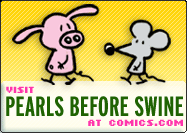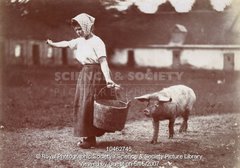those who do evil, but because of those who look on
and do nothing".
- Albert Einstein

Sunday, February 21, 2010
Flatulent pig sparks gas leak scare
By Tom Chivers
Published: 11:37AM GMT 27 Nov 2009
Telegraph.co.uk
The farmer in Axedale, a town in Victoria in the south-east of the country, called the emergency services after believing he had smelled gas.
But when the fire crews arrived, they found the real culprit – a 260lb sow the family's children kept as a pet.
“We could not only smell it, but we heard it and it was quite funny."
He added: "She got very excited when two trucks and 15 firies turned up and she squealed and farted and squealed and farted.
"I haven't heard too many pigs fart but I would describe it as very full-on."
However, despite the false alarm, Mr Harkins said the farmer had done the right thing by calling 000 (the Australian equivalent of 999). He told The Melbourne Herald Sun: "It's all bottled gas up here and a leaking cylinder could pose a major fire risk.
"It was because we took it so seriously that 15 volunteers still managed to attend the call out at 10.30 on Tuesday night."
Some Pig! A Heartwarming Tail of Pig Friendship
Great post on Paw Nation!
Saturday, November 14, 2009
Pigs join the ranks of domesticated animals with sequenced genomes
DVM NEWSMAGAZINE
Champaign, Ill. -- Dogs, cats, horses, cows, and now pigs. A first draft of the swine genome has been mapped, according to the University of Illinois at Urbana-Champaign. The pig whose genes have been sequenced is a red-haired Duroc from a farm at the University of Illinois.
Most of the sequencing was performed at the Wellcome Trust Sanger Institute, based in Hinxton, England, but help was provided by scientists and genome-sequencing centers around the world. Funding was a global effort as well, with the $24.3 million bill to complete the sequencing footed by the USDA National Institute of Food and Agriculture, the USDA Agricultural Research Service, and American, Asian, and European funders.
Researchers will now be able to use the genome to search for genes that can improve pork production and breeding practices, provide clues to swine diseases, and help preserve endangered and wild pigs globally. In addition, pigs are often used as human models of disease since the two species are similar physiologically and behaviorally and have related nutritional needs. So the swine genome will also benefit research into human health.
"This sequence provides a tool of real value in helping the research community to better understand human diseases, in particular by facilitating cardiovascular, pulmonary, gastrointestinal and immunological studies," says Allan Bradley, director of the Wellcome Trust Sanger Institute. "Thanks to the immediate release of sequence data as it has been produced, the scientific impact of this research is already being felt."
Thursday, October 1, 2009
Bidgiemire Pig Arks - UK


Thursday, July 2, 2009
Friday, June 5, 2009
Meet Elbert - and Kudos to Lydia
Here is a description of Lydia's "program" to save Elbert:
Elbert was fed free choice Science Diet dog food for years. He was kept on a concrete floor with a litterpan, even in the summer....no outside time because he got so fat, and his feet were so neglected he could not walk at all. He lived like this until the age of 6 when he arrived at my house last August (2008).
He was estimated at 250lbs + when he got here but with some time and dieting he is now about 140-150lbs and mobile.
I fed him 3/4 cup of the Mazuri Elder twice a day, plus lots of low cal veggies. We have a huge garden so every day he got salad, tomatoes, squash, zuchinni, watermelon rinds, cantaloupe rinds, etc. These are mostly water filled items and while they taste great and are satisfying, they don't pack on pounds readily. I gave him several cups of the veggies....whichever I had extra of....every day.
Exercise was critical to Elbert's success. At first he was not strong enough to support his own body weight, even after getting his feet trimmed so he could stand. I would use a grape to bait him around the stall. First few days he could only walk about 4 or 5 steps before going back to his knees. We built on it every day. I would never take his food to him, but made him come across the 12ft stall to get his meals. No matter which spot he chose to lie down, I made him move to eat. Over time he got stronger and stronger.
At first he would eat on his knees, but now he stands to eat. He is finally out and about, doing remarkably well all things considered. His knees ar permanently bent and he takes meloxicam for that, but even there he is going much better, and I have cut way back on his dose.
Here is a video we did of Elbert that chronicles his long and rather arduous journey. He's been here 10 months and really has made remarkable progress. Likely he's about as good as he will ever be and The Snelbert stands as the poster child for what NOT to do with a pig food-wise. I don't forsee an exceptionally long life for him, with his leg problems arthritis will likely take him fairly young, but I am determined to make whatever years he has very, very happy years.
Thursday, May 7, 2009
The Lighter Side of Swine 'Flu
Friday, April 3, 2009
H5N1 virus may be adapting to pigs in Indonesia
CIDRAP News - March 31, 2009
Scientists report that H5N1 avian influenza viruses may be adapting to pigs,as evidenced by the finding that H5N1 viruses isolated from pigs in Indonesia were less harmful to mice than were H5N1 viruses from chickens. The finding suggests that in growing in pigs, the virus may have become lessharmful to mammals in general, the authors report. That sounds reassuring,but the authors say it may mean the virus is one step closer to turning into a human pandemic strain. In the study, scientists from Japan and Indonesia collected viruses from chickens and pigs in Indonesia, grew them in laboratory cell cultures, and used them to infect mice. They found that the viruses from pigs were less lethal to mice than the viruses from chickens,according to their recent report in the Archives of Virology. "We found that swine isolates were less virulent to mice than avian isolates, suggesting that the viruses became attenuated during their replication in pigs," thereport states.
Full text: http://tinyurl.com/c6h8f4








